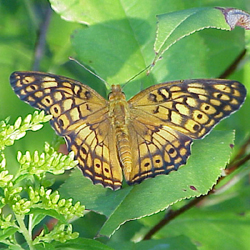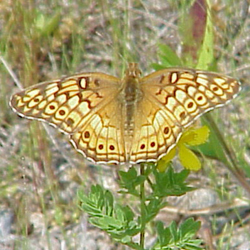Find a Butterfly
Variegated Fritillary
Euptoieta claudia
Named
Cramer, 1775

Identification
Wingspan: 1 3/4 2 1/4". Most likely to be confused with larger and commoner Speyeria fritillaries, but lacks silver spots below, is tawnier above, with more elongate forewing and squarish, not rounded hindwing. Forewing tip and hindwing below are variegated brown and frosty gray. Early season adults are distinctly smaller than late season individals.
Distribution
Resident from southern California across the southern Great Plains to Florida, south through Central and South America to Argentina. Also, the Greater Antilles. Summer flights advance the species range northward to southern Canada, and occasionally as far north as the Northwest Territories. In New England, known primarily from the southern half, the species ranging north to southern Vermont, New Hampshire, and coastal Maine.
Status in Massachusetts
Widespread, though generally rare to uncommon in Massachusetts. It occasionally becomes locally abundant. The Variegated Fritillary moves north into Massachusetts as early as late spring, and numbers increase until early fall. Scudder considered this a rare butterfly in Massachusetts and listed only seven individual records for the state. Farquhar called it a stray, which "apparently breeds here" from July to September. He noted larvae found in July and September. The Atlas provided twenty-one records, the majority of which involved more than one individual. There were no Atlas reports from Martha‘s Vineyard, Nantucket, or the Berkshires, although historical records exist for Nantucket (Kimble and Jones) and Berkshire County (R. Wendell Coll.). Maximum: 162 adults and 2 larvae counted at two different areas of the Wachusett Reservoir (Worcester Co.) on 30 September 1989.

Flight Period in Massachusetts
Typically flies from July through October, with one or possibly two broods during good years. Extreme dates: 29 May 1991, Foxboro (Norfolk Co.), B. Cassie, and 14 November 1989, Wachusett Reservoir (Worcester Co.), T. Dodd.
Larval Food Plants
This wide ranging species feeds on a variety of plants in a number of families, including violets and pansies (Viola), flax (Linum), Moonseed (Minispermum canadense), Purslane (Portulaca oleracea), Mayapple (Podyphyllum peltatum), Stonecrop (Sedum lanceolatum), and plantain (Plantago, spp.). Documented from Massachusetts are Lance leaved Violet (Viola lanceolata),(T. Dodd) and cultivated thyme (Thymus)(M.Mello).
Adult Food sources
Visits many species of flowering plants, including Small White Aster, Stiff Aster, Fall Dandelion, Golden hedge Hyssop, Purple Milkwort, Boneset, Round headed Bush Clover, Wild Indigo, and goldenrods.

Habitat
Grasslands, open fields, waste areas, meadows, and other open and disturbed areas. In recent years, found most abundantly in Massachusetts along lake shorelines (e.g. Quabbin Reservoir and Wachusett Reservoir) during periods of low water. Here, in the zone below the high water mark, one of this species‘ larval host plants Lance leaved Violet grows abundantly.
Life Cycle
EGG: Cream colored or pale green; dome shaped and ribbed. OVIPOSITION: Eggs laid singly on leaves or stems. LARVA: Reddish orange, with two lengthwise white stripes on each side and several rows of branched black spines. CHRYSALIS: Whitish, with orange tubercles and numerous black spots. Stage lasts approximately eleven days. OVERWINTERING STAGE: Early instar larva, but does not overwinter in New England. According to Scott (1986), this largely tropical species may not undergo a true diapause.
Adults fly north from the permanent southern range in spring, typically reaching New England by summer. In Massachusetts, females have been observed ovipositing from early August until late October. Larvae feed at night and mature in about two weeks, feeding on host plant leaves and flowers. Variegated Fritillaries can often be seen on the ground, basking in the sun with their wings spread. Their flight is fast and they fly close to the ground, making them difficult to follow.
Account Author
Tom Dodd



